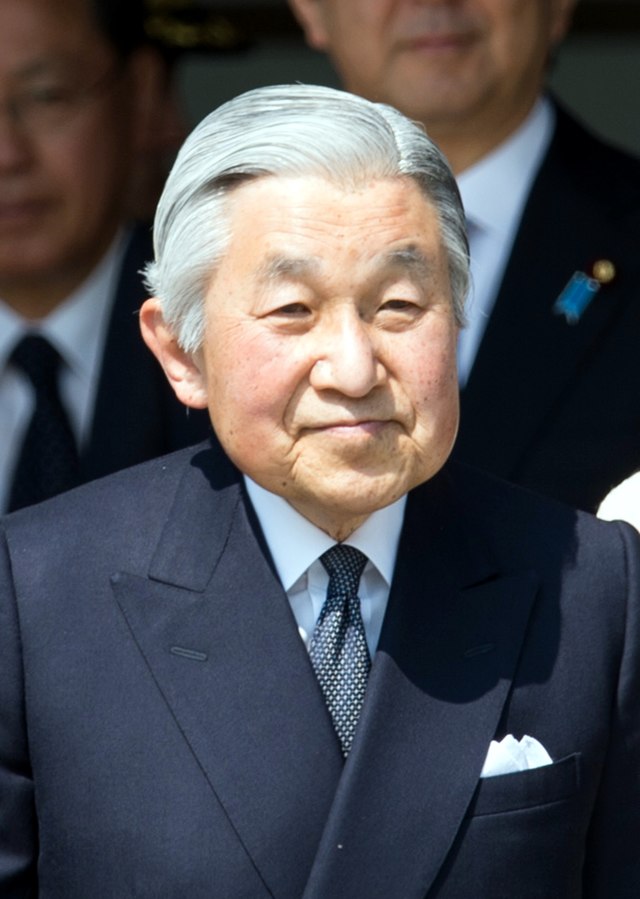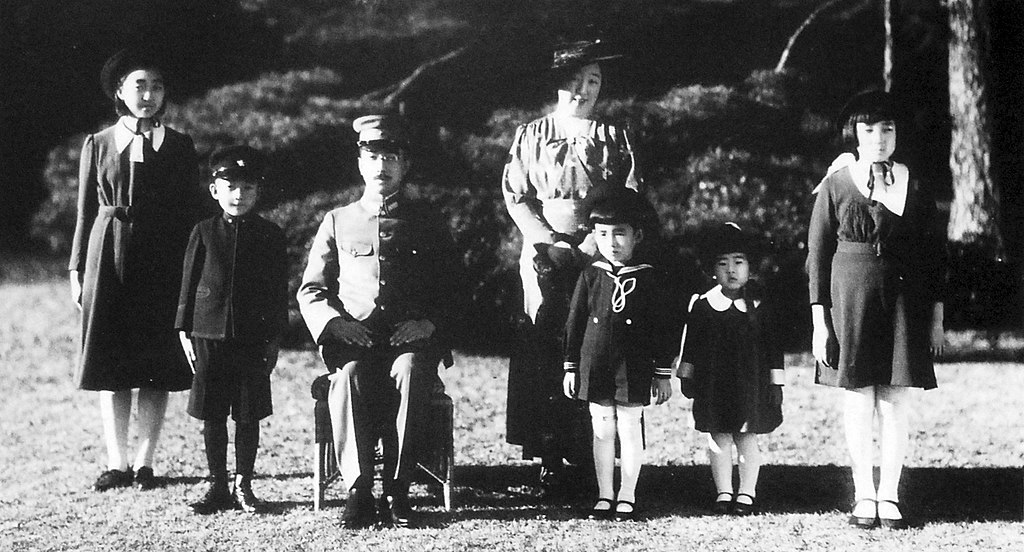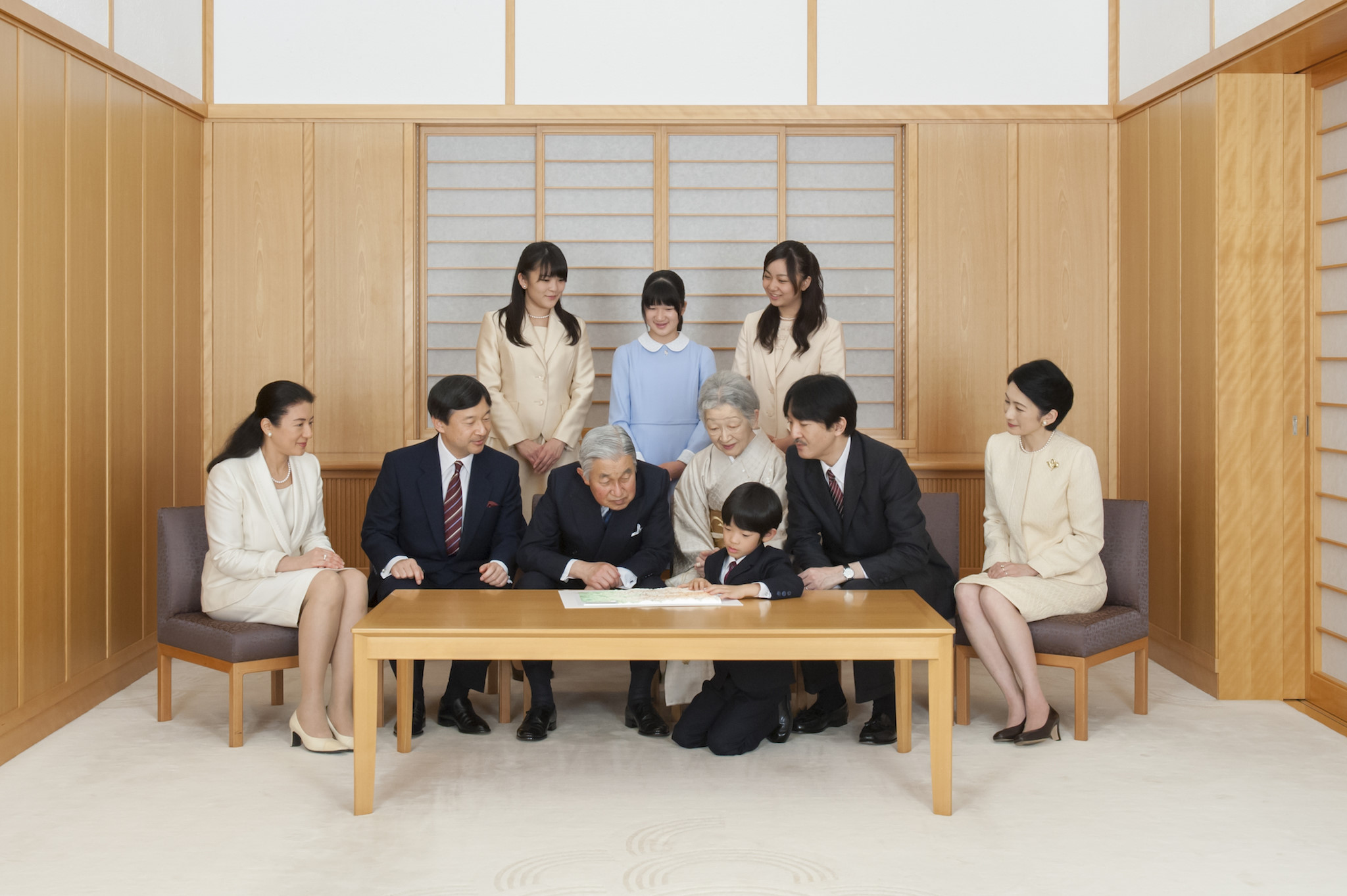by Scott Mehl and Susan Flantzer
© Unofficial Royalty 2014

Emperor Akihito of Japan; Credit – Wikipedia
Emperor Akihito of Japan was born on December 23, 1933, at the Tokyo Imperial Palace in Tokyo, Japan. He was the fifth of the seven children and the eldest son of Emperor Hirohito and Princess Nagako of Kuni. Akihito was heir-apparent to the Chrysanthemum Throne from birth.

Akihito and his mother; Credit – Wikipedia
Akihito had five sisters and one brother:
- Shigeko, Princess Teru (1925 – 1943), married Prince Morihiro Higashikuni, had five children
- Sachiko, Princess Hisa (1927 – 1928), died young
- Kazuko, Princess Taka (1929 – 1989), married Toshimichi Takatsukasa, lost her imperial status due to marrying a commoner, adopted one son
- Atsuko, Princess Yori (1931 – 1952), married Takamasa Ikeda, lost her imperial status due to marrying a commoner, no children
- Masahito, Prince Hitachi (born 1935), married Hanako Tsugaru, no children
- Takako, Princess Suga (born 1939), married Hisanaga Shimazu, lost her imperial status due to marrying a commoner, had one son

Japanese Imperial Family, 1941; Credit – Wikipedia
Akihito, titled Prince Tsugu, was initially educated by tutors at the Imperial Palace before completing his elementary and secondary education at The Gakushūin (Peers School) in Tokyo. During the American Occupation of Japan, following World War II, Akihito and several of his siblings were tutored in English and Western culture. He later briefly attended Gakushuin University, studying Political Science, but did not obtain a degree. On November 10, 1952, he was formally invested as Crown Prince in a ceremony held at the Imperial Palace.

Akihito’s investiture as Crown Prince; Credit – Wikipedia
Akihito first met his future wife Michiko Shōda, the eldest daughter of a wealthy flour company executive, on a tennis court in August 1957. The Imperial Household Council formally approved the engagement of Crown Prince Akihito to Michiko Shōda on November 27, 1958, and the engagement ceremony took place on January 14, 1959. It would be the first time a commoner married into the Imperial Family. The engagement announcement drew criticism from traditionalist groups because Michiko came from a Roman Catholic family. She had never been baptized but had been educated in Catholic schools and seemed to share the faith of her parents. There was much speculation that Akihito’s mother strongly opposed the marriage. After the marriage, she treated her commoner daughter-in-law harshly. Akihito and Michiko were married in a traditional Shinto ceremony on April 10, 1959.

Akihito and Michiko on their wedding day with Emperor Shōwa and Empress Kōjun; Credit – Wikipedia
Akihito and Michiko had two sons and one daughter:
- Emperor Naruhito of Japan (born 1960), married Masako Owada, had one daughter
- Crown Prince Akishino (born 1965), married Kiko Kawashima, had two daughters and one son
- Sayako, Princess Nori (born 1969), married Yoshiki Kuroda, lost her imperial status due to marrying a commoner, no children
Akihito ascended the Chrysanthemum Throne on January 7, 1989, upon the death of his father Emperor Hirohito. His formal enthronement took place on November 12, 1990. During his reign, Emperor Akihito made an effort to bring the Imperial family closer to the Japanese people. Emperor Akihito and Empress Michiko made official visits to foreign countries and all forty-seven Prefectures of Japan. In response to the 2011 Tōhoku earthquake and tsunami and the Fukushima I nuclear crisis, Emperor Akihito made a historic televised speech urging the Japanese people not to give up hope and to help each other.
Emperor Akihito has had several health issues. He underwent surgery for prostate cancer in 2003. In 2011, he was admitted to the hospital suffering from pneumonia. In February 2012, after having a coronary examination, the Emperor underwent successful heart bypass surgery.

Emperor Akihito and Empress Michiko with their sons and their families in 2013; Photo Credit – Wikipedia
Emperor Akihito shares his father’s interest in marine biology. He is a published ichthyological researcher, has specialized in studies within the taxonomy of the family Gobiidae, and has written papers for scholarly journals such as Gene and the Japanese Journal of Ichthyology.
In 2016, Emperor Akihito gave a televised speech emphasizing his advanced age and declining health that was interpreted as a desire to abdicate. On June 8, 2017, the National Diet, the Japanese legislature, passed a bill allowing Akihito to abdicate. On December 1, 2017, Japanese Prime Minister Shinzo Abe announced that Emperor Akihito would abdicate on April 30, 2019, in favor of his elder son Crown Prince Naruhito. The last abdication occurred 200 years ago when Emperor Kōkaku abdicated in 1817.
The era of Emperor Akihito’s reign bears the name “Heisei” and according to custom, he will be renamed “Emperor Heisei” after his death. After Akihito abdicated on April 30, 2019, he was entitled Jōkō, an abbreviation of Daijō Tennō (Emperor Emeritus), and the new era Reiwa was established for his son and successor Emperor Naruhito.

Emperor Akihito and Empress Michiko; Credit – Wikipedia
After the abdication, Akihito and his wife Michiko lived temporarily at the Takanawa Imperial Residence, formerly the home of Prince and Princess Takamatsu, Akihito’s aunt and uncle. It had been empty since the death of Princess Takamatsu in 2004. They then moved to Togu Palace at the Akasaka Estate, the former home of Emperor Naruhito and his family. Togu Palace was renamed Sento Imperial Palace, which translates as “the place where the retired imperial couple live.”
This article is the intellectual property of Unofficial Royalty and is NOT TO BE COPIED, EDITED, OR POSTED IN ANY FORM ON ANOTHER WEBSITE under any circumstances. It is permissible to use a link that directs to Unofficial Royalty.
State of Japan Resources at Unofficial Royalty
